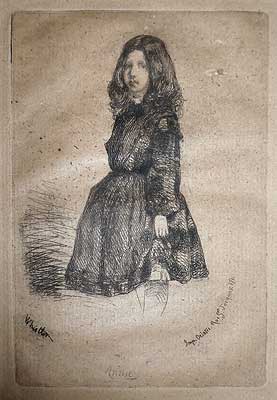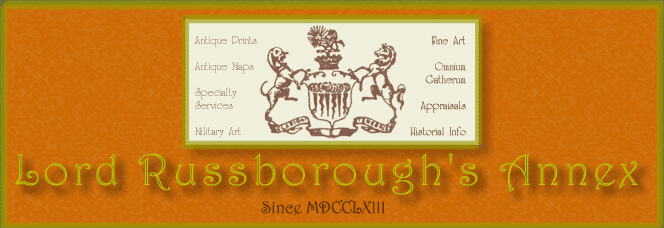
A SCARCE ORIGINAL ETCHING BY
JAMES ABBOT MACNEILL WHISTLER
American
1834 - 1903
ANNIE
from 'The French Set' Paris 1858
Kennedy 10 v/v etching, on hand-made laid paper.
4 5/8 x 3 1/8 " 12 x 7.8 cm.
Ref. PR2(97) /ELN/s.ando >DOLN PRICE CODE F
The subject is Whistler's neice, Annie Haden, who at the time of this etching would have been about 9 or 11 years old.
Annie was the daughter of his brother-in law, mentor, and etching companion Sir Seymour Haden.
It was Haden who added the legs to this state of the print (the final state # 5 of 5 states )
an addition rather to the annoyance of Whistler.
James Abbott McNeill Whistler, (July 11, 1834, Lowell , Massachusetts, U.S., - July 17, 1903, London, England), American-born artist noted for his paintings of nocturnal London, for his striking and stylistically advanced full-length portraits, and for his brilliant etchings and lithographs. An articulate theorist about art, he did much to introduce modern French painting into England. His most famous work is Arrangement in Grey and Black No. 1 (1871; also called Portrait of the Artist’s Mother or Whistler’s Mother). Like many of his compatriots he was fascinated by Paris, where he arrived in 1855 to study painting and soon adopted a Bohemian lifestyle. He was drawn to the French modern movement, responding to the realism associated with the painters Gustave Courbet, Henri Fantin-, and François Bonvin, all of whom he knew. The realistic streak in his art may be seen in such early works as Self-Portrait (c. 1857–58) and the Twelve Etchings from Nature (1858; also called The French Set) of which Annie is one.



